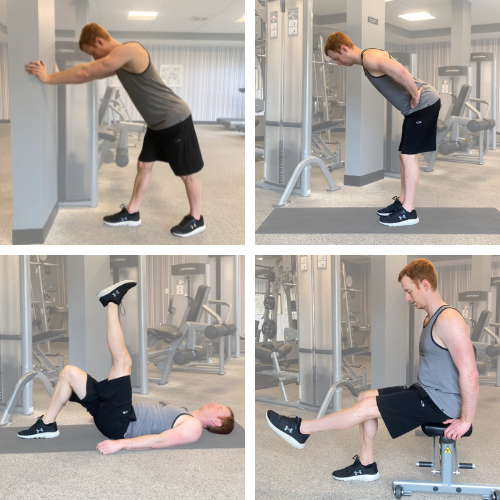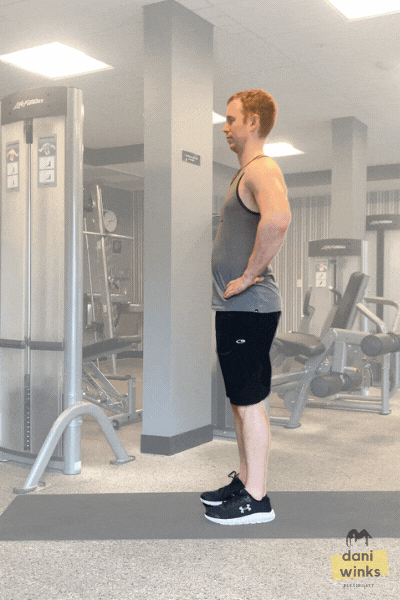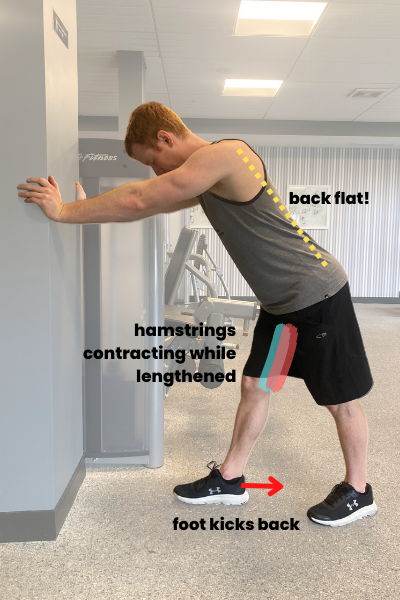4 Active Hamstring Stretches for Beginners
4 Active Hamstring Stretches for Beginners
If you have tight hamstrings, you may have heard this could be because either “short” (which would imply you should stretch) or that they’re “weak” (which would imply you should strengthen, because stretching would only make them weaker…). So what’s a toe touching wannabe to do?
The short answer: do both. Strengthen while your hamstrings are being stretched. By strengthening your full range of motion, you’re teaching your hamstrings to support your body in those positions, and after those muscles go through their repair cycle, they’ll be more apt to let you stretch to that deeper range of motion. And when it comes to your hamstrings, you’ll want to strengthen both the hamstrings themselves (duh), but also the hip flexors (the main “mover” muscles on the opposite side of the hip joint).
This style of flexibility training where you use your own strength to work your flexibility is called active flexibility and it is arguably the best way to increase your flexibility - whether you’re just trying to be able to touch your toes for the first time since your were 6, or you want to be able to do a Jean-Claude Van Damme style box split across two speeding tractor trailers.
Related post: What is “Active Flexibility” and Why is It So Important?
Before you dive into the stretching exercises, make sure you do a proper 5-10 minute warm up (unless you’re tacking this on to an existing exercise routine), and consider doing a set of gentle sciatic nerve glides and tensioners, especially if you usually feel “hamstring stretches” in your back, calves, or feet (which is a sign you might have some sciatic nerve tension and should avoid deep prolonged stretching in positions that tense your nerves). I also like starting with some gentler passive stretches like these before diving into the more challenging active/strengthening work.
4 Beginner-Friendly Active Flexibility Exercises for Your Hamstrings
As a reminder, when doing these hamstring stretches it’s important to keep your back flat (avoid letting it round). Rounding the back does not help your hamstrings and is a common way to “cheat” the stretch. Rounding your back can even make things worse by increasing the nerve tension in your sciatic nerve, which can lead to more hamstring tightness than you started with. Your goal for these exercises isn’t to lean as much as you can and touch your hands to your toes - it’s to feel a stretch in your hamstrings. Don’t worry so much about what it looks like.
1. Bodyweight Good Mornings
This is my classic go-to - if you only do one exercise out of the list, have it be this one! This is such a great exercise because it helps us strengthen our hamstrings across a full range of motion, including when they are stretched to an end range position, which is typically where muscles are weakest (and why they resist stretching).
Start standing, with feet hip-width apart, knees slightly bent
Keeping your back flat, start to tilt your pelvis forwards to forward fold. Only lean as far as you can while keeping your lower and upper back flat, until you feel a deep stretch in your hamstrings. Don’t worry if you can’t lean very deep - it’s better to keep your back flat and hip hinge less than letting your back round and compromising the stretch.
Once you’ve found your hamstring stretch, press both feet into the ground to engage (contract) your hamstrings as you lift your torso back to standing. That’s one rep, repeat for 8-12 reps.
Need to make it easier: Bend your knees even more - don’t fear the knee bend! You can also place your hands on your thighs to support the weight of your upper body as you lean and lift your torso
Want to make it harder? Reach your arms out to the side, or straight overhead (or even hold a weight) to make your hamstrings work harder to lift your torso back from your forward fold
Variations:
Wide-Leg Good Mornings
This is a nice variation if you’re working on a straddle pancake, since it stretches your hamstrings in a similar position to when you’re sitting in a straddle on the floor.
High Pyramid Good Mornings
Staggering your stance here lets you focus on feeling the stretch (and contraction) in just the front leg. If you’re looking for a challenge or prefer to isolate one leg at a time, this is a great option for you.
2. Standing Foot Staggered Contract-Relax
For beginners, I prefer doing contract-relax from a supported (leaning on a chair or into the wall) standing forward fold as opposed to doing the classic “lying on your back” hamstring PNF because it’s much gentler on the hip flexors, which sometimes try to over-engage when we’re lying on the ground (but we’ll address those next!)
Start standing a foot or two (or three…) away from a wall (or pole / chair / etc - any support surface you can put your hands on for balance). You’ll want enough space to forward fold and have your hands on the wall for support, so how far away you stand will depend on your hip flexibility. Stagger your legs so your right leg is in front, toes pointing toward the wall (this is the leg we’ll be working on first), and your left leg a foot or two behind, with toes slightly angled out to the side for balance. Try to keep your pelvis rotated toward the wall (hips “square” toward the wall)
Keeping your back flat, forward fold by tilting your pelvis forward, until you feel a stretch in the right hamstring, placing your hands on the wall for support. (Again, if you have tight hammies, you may not have to lean very far before you feel that hamstring stretch!)
Hold the passive stretch for 10-15 seconds to get used to the stretch
Contract Round 1: Contract your hamstrings while they are in the stretched position by trying to pull your right foot back while in your forward fold. You don’t want the foot to actually move (so wearing shoes or taking socks off can help keep the foot gripping the floor. Alternatively, you can place a weight like a dumbbell behind your front foot). Aim for a “5 out of 10” intensity of contraction - not literally trying to kick the leg back so hard it moves, but enough that you can feel a bit of tension build in the hamstrings. Hold the contraction for 6-10 seconds
Relax Round 1: Stop pulling the right foot back and let the front leg relax. If it feels comfortable, you can lean forward slightly more to deepen the stretch. But don’t worry if you feel like you’re at your maximum stretch already, you can just continue to hold the passive, relaxed stretch, leaning as much weight into your hands on the wall as you need. Hold the relaxed stretch for 10-20 seconds
Contract Round 2: Repeat the hamstring contraction and hold the tension for 6-10 seconds
Relax Round 2: Relax the hamstring (stop kicking the foot back) and hold the passive stretch for 10-20 seconds
Contract Round 3: Do one final round of contracting (pulling your front foot back, tensing the hamstring while it’s in the lengthened position) for 6-10 seconds
Relax Round 3: Relax the front leg and hold the passive stretch for a last 10-20 seconds
Lift your torso to come out of the stretch, shake that right leg out if it needs a shake break, and repeat for 3 rounds of contract-then-relax with your left leg forwards
3. Supine Leg Kicks
So far all the exercises in this list (good mornings and the staggered foot contract-relax) have all been aimed at strengthening your hamstrings while they are in a lengthened position. It’s also important to strengthen your hip flexors, which are on the opposite side of the hip joint, while the hamstrings are in a lengthened position as well. These lying down leg lifts do just that!
Start lying down on your back with your right knee bent, right foot on the floor, and left leg extended long (the left leg is going to be our working leg)
With control (don’t use momentum), slowly lift the left leg away from the floor, kicking it towards your chest as much as you can without letting your pelvis tilt (you can think about keeping your tailbone extending long toward the end of your mat, trying not to let it curl up toward the ceiling as you lift your left leg)
Slowly lower the left leg back down. That’s one rep, repeat for 5-12 reps, then switch legs
Need to make it easier? Generously bend the left knee
Want to make it harder? Straighten the right leg and keep the whole right leg flat on the floor as you lift your left leg (although, honestly, I wouldn’t really consider that a “beginner friendly” variation - that makes the exercise quite a bit harder!)
4. Hip-Elevated Seated Leg Lifts (& Forward Fold)
This is another hip flexor strengthener that takes advantage of the theory of “reciprocal inhibition” - our bodies are generally smart enough that when we contract a muscle on one side of the joint, we relax the muscles on the opposite side to allow for movement to happen. So when we contract our hip flexors to pull our knee toward our chest, our hamstrings have to relax to allow for that action to occur. By doing a couple of reps of hip flexor contraction, then immediately following with a hamstring stretch, you can take advantage of your hamstrings being in that slightly-more-relaxed-state to (potentially) get a deeper stretch.
Start sitting in a chair or on a bench with your right knee bent and left leg extended straight in front of you, foot on the floor - the left leg will be our working leg
Keeping your back flat and torso upright, lift your left leg off the floor, then slowly lower back down. Repeat for a total of 5-10 reps
After your last leg lift, immediately take a forward fold: keep your back flat and lean forwards to find your hamstring stretch. As always, focus on finding the stretching sensation, don’t worry about how far (or not far…) you’re able to actually lean. Hold this passive stretch for 15-30 seconds
Repeat the 5-10 leg lifts + 15-30 second forward fold on the right leg
Need to make it easier: Slightly bend the working leg
Want to make it harder? Add a small forward fold and try to lift your working leg while leaning forwards slightly (honestly just an inch or two will probably be enough to feel a significant difference)
How Often to Do These Drills?
Try incorporating these exercises (after a warm up, or after a workout while your muscles are still work) 2-3 days a week. Don’t forget to add in a quick nerve glide first if you have sciatic nerve tension. Consider doing some gentle passive hamstring stretches like some of these (ex. legs up the wall, lying down hamstring stretch with a strap, downward dog with bent knees) before diving into your more “muscle-y” active flexibility work.
Typically you can expect to see progress - whether that’s visibly being able to stretch farther, or just being more comfortable in a stretch - in 4-6 weeks.
Best of luck on your toe-touching progress!








